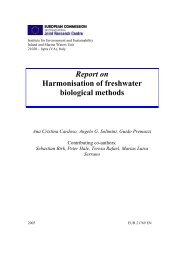Lakes and Watercourses
Lakes and Watercourses
Lakes and Watercourses
Create successful ePaper yourself
Turn your PDF publications into a flip-book with our unique Google optimized e-Paper software.
TABLE 34.<br />
Reference values for planktonic algae in various lake types<br />
Indicator Lowl<strong>and</strong> lake, Lowl<strong>and</strong> lake, Forest Mountain<br />
shallow* deep* lake* lake*<br />
Total volume, seasonal average, mm 3 /l 1 0.5 0.5 0.5<br />
Total volume, August, mm 3 /l 1.5 0.75 0.5 0.5<br />
Diatom biomass in April/May, mm 3 /l 1 1 0.5 **<br />
Water-blooming cyanobacteria in August, mm 3 /l 0.5 0.5 0.05 **<br />
No. of potentially toxin-producing 4 4 3 2<br />
cyanobacteria (genera) in August<br />
Gonyostomum semen, biomass in August, mm 3 /l 0.1 0.1 0.1 **<br />
* Mountain lake: situated above the tree line<br />
Forest lake: usually, but not always, situated above the reference elevation, referred to in Sweden<br />
as ”the highest coastline”, where surrounding l<strong>and</strong> comprises > 60% forest<br />
Lowl<strong>and</strong> lake: situated on mud sediments, usually below the highest coastline, where surrounding<br />
l<strong>and</strong> comprises > 60% cultivated l<strong>and</strong> (arable l<strong>and</strong>, meadow, fallow, other grazing l<strong>and</strong>).<br />
** No reference values available or the parameter is not relevant to the lake type.<br />
Comments<br />
Classification must be based on samples taken <strong>and</strong> analysed in accordance<br />
with the Swedish EPA Environmental Monitoring H<strong>and</strong>book.<br />
Assessment need not necessarily be made using all parameters for a given<br />
lake. The choice of parameters is governed by the aspects of the presence<br />
of planktonic algae to be highlighted <strong>and</strong> the availability of background<br />
data. Hence, in some cases assessment will be confined to harmful algae.<br />
In others, assessment may focus on biomass quantities in parallel with the<br />
presence of toxic algae.<br />
In oligotrophic lakes, where there is often little difference from one<br />
year to another, results from a single year may be used for assessment. In<br />
moderately eutrophic <strong>and</strong> eutrophic lakes, on the other h<strong>and</strong>, data<br />
should comprise figures from three years of study, so as to obtain mean<br />
values. Variations between years due to weather have a particularly<br />
marked impact on species balance <strong>and</strong> quantities of various algal groups<br />
in such lakes, which in turn affects total biomass. If an assessment is made<br />
using more limited data, this should be stated.<br />
The scales for the respective parameters, as with the choice of parameters<br />
<strong>and</strong> reference values, are intended to be used during a trial period.<br />
57















![Accommodation booking form [PDF]](https://img.yumpu.com/39471785/1/184x260/accommodation-booking-form-pdf.jpg?quality=85)

